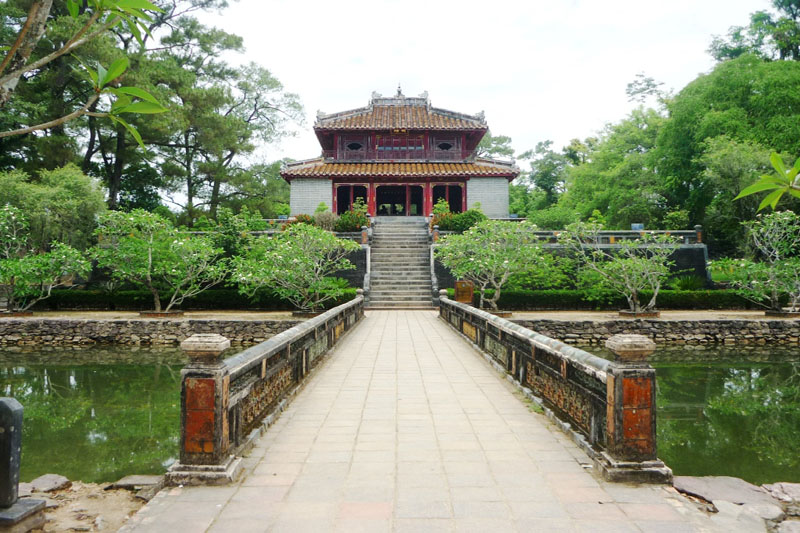Stop by, even if it’s just for a day, to travel back in time, learn about the country’s rich history and traditions and try unique regional delicacies. Explore breathtaking landscapes and scenery as you travel to the famous royal tombs in the city’s vicinity.
Hue – A quick introduction

Located in the geographical center of Vietnam, Hue sits on the Perfume River, only a few minutes from the coast of the South China Sea. The surrounding hills and mountains made this the perfect location for Emperor Gia Long, the first ruler of the Nguyen Dynasty, to found his country’s new capital in 1802. From then on, Hue was the administrative and military center of a now unified Vietnam.
The proof of this history can still be seen very clearly today. The Citadel, Hue’s most important historical and cultural sight, occupies a prominent place in the middle of the city. It represents an excellent example of an eastern feudal city. Apart from this, there are numerous royal tombs, pagodas and temples inside and around the city, making it one of Vietnam’s most important cultural and historical centers. This is what got the attention of UNESCO who named the complex of Hue monuments a World Heritage Site in 1993.
The history of Hue imperial city
Since the beginning of the Nguyen Dynasty, Hue had been the growing influence of the French and the regular attacks by neighboring kingdoms – the Champa and the Khmer. This played an important role in Hue’s history and greatly influenced life in Vietnam.
The early Nguyen rulers did their best to minimize the effect of foreign influences on their country. But later on, Emperors Khai Dinh and Tu Duc are said to have been strongly impacted by the French. In particular, Tu Duc was considered more of a salaried employee of the French rather than a monarch.
With the end of Vietnam’s monarchy in 1945, the country’s capital was moved back to Hanoi. But Hue remained an important city nonetheless.
As the center of the Buddhist faith in Vietnam, Hue was and still is home to numerous monasteries. However, due to the strong missionizing efforts of the French, Catholicism started gaining followers, especially among people in influential positions.
In the early 1960s Buddhists were being systematically oppressed and were strongly discouraged from practicing their faith publicly. This lead to demonstrations and ultimately to several Buddhist monks burning themselves alive as a sign of protest.
Several years later, its geographical location close to the Demilitarized Zone (DMZ) made Hue the scene of bloody battles during the Vietnam War. The Tet Offensive of 1968 is most well-known. During this fight, the Forbidden Purple City, the innermost part of the Citadel was largely destroyed. Even today the damage can be seen as artisans are carefully working to rebuild and restore it.
When to travel to Hue
1. Weather in Hue
Hue has a severe weather condition
Being a part of Central Vietnam, Hue has severe weather condition. Due to its location in the tropical monsoon belt, Hue receives a considerable volume of solar radiation, it’s about 70 – 85 Kcal/cm² per year. In addition, for being under the influence of Southwest wind blowing from Laos, Hue is considerably hotter than nearby regions such as Hoi An and Da Nang. The average temperature is around 25oC. The hottest month is August with the daylight temperature is up to 34oC. The coolest time is from December to January with the average temperature is around 20,3oC. The annual precipitation is estimated from 3,100 mm to 3,250mm. The Truong Son Mountains in the South bottle up all the moisture. That’s the reason why Hue is usually misty, and drizzly. Hue has pretty high humidity which is around 86.7%. Humidity is often higher than usual in the rainy season, especially from February to the end of March.
Hue’s climate is generally hot and humid. But if you can plan your trip between February and April, you will most likely experience cooler and drier weather. If you don’t mind the heat, June and July are an option as well but be prepared for the temperatures to be in the low thirties with high humidity. The time to avoid Hue is from August to December as this is the rainy season. During this time, you risk losing an entire day to downpours which make it very unpleasant to visit any of the city’s sights (they are all outdoors).

Hue has two indistinct seasons
Hue climate features common traits of the transition region between subequatorial climate and inter-tropical climate. Therefore, Hue has two indistinct seasons including winter and dry season. Summer often lasts from April to September. During these months, especially from July to August, Hue has the scorching heat. It’s also drier due to the winds blowing from Lao. It only gets a bit cold in the winter from October to March since when northeast monsoon. Like other regions in Central Vietnam, Hue suffers a lot of tropical storms which often appears from June and occurs in high density between September and October.
2. When is the best time to visit Hue, Vietnam
From February to March
The perfect time to visit Hue is from February to March. During these months, the weather is cooler. The average temperature ranges from 20oC to 22oC, which makes it more comfortable to go outside and explore the beauty of this city. In addition, the precipitation in these months is lowest throughout the year. So that you don’t have to worry that the rain may ruin your vacation.This time also concurs with the beginning of Lunar New Year. Therefore, it’s the ideal time to visit spiritual destinations such as Thien Mu Pagoda, Hung Khanh Pagoda, Bao Quoc Pagoda and Thien Lam Pagoda.
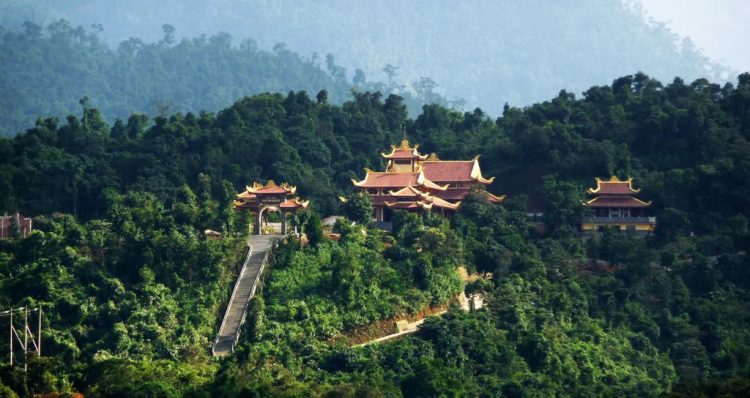
From October to January
From October to January is also an ideal time to visit Hue when it starts cooling off. During these moths, Hue suffers many heavy spots of rain, several ones even bear tropical storm. Heavy rains may prevent you from scrolling around the city. However, you still can visit historical sites such as An Dinh Palace, Temple of Literature, and Museum of Royal Antiquities. From October to January is also the time when many remarkable festivals are celebrated in Hue. Visiting Hue in these months, you can have golden chances to enjoy the Nha Nhac (Vietnamese Court Music), which is recognized as the Masterpiece of the Oral and Intangible Heritage of Humanity.
How to travel to Hue
1. Getting to Hue
By airplane – the fastest way to travel

Phu Bai International Airport is 15 kilometers from Hue City and takes about half an hour to get from the airport to downtown Hue. In the past, Phu Bai International Airport was chiefly used by the French and the Americans. But since 1975, it has been transformed to server civilization purpose. As featuring limited size, Phu Bai Airport is able to receive only medium-sized planes such as Airbus A320, and Boeing 747. To travel by airplane, you can book the online ticket from one of the most popular OTA (baolau.com or 12Go.asia).
The cheapest way to travel from Phu Bai Airport to the center city is taking an airport bus which cost you from VND 30,000 to VND 40,000. If you have a lot of luggage, it’s better for you to take a private car (Private Phu Bai International Airport Transfers (HUI) for Hue).
By train –The most interesting way to travel

Hue Railway Station lays on the main North-South Railway. Constructed by the French colonial authorities during the French Indochina period, Hue Railway Station is considered one of the most beautiful stations in Vietnam. Nowadays, Hue Railway Station handles passenger and cargo transportation from the North to the South and is an important transit point of the Center of Vietnam.
To get more information of other train route and book the tickets, you can visit most popular OTA (baolau.com or 12Go.asia). Alternatively, you can purchase tickets from the ticket booths at the city train stations. However, you might face the risk of running out of tickets. Therefore, it’s better to book in advance.
By open bus – The cheapest way to travel
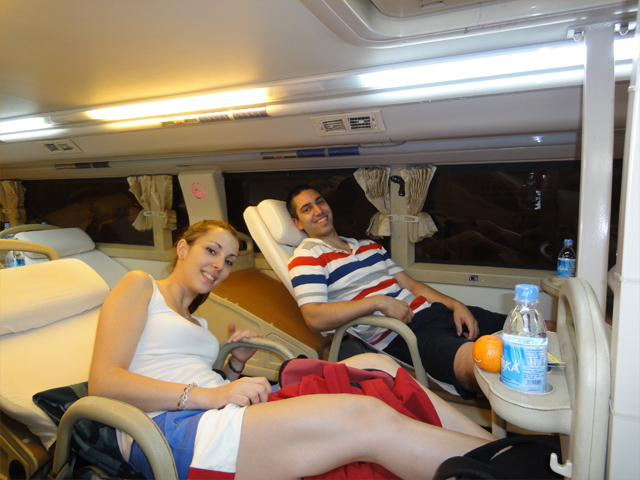
There is no doubt that getting to Hue by open buses is the cheapest way. Since this city is a popular destination in Central Vietnam, there is a considerable number of bus operators. That’s why you will have a lot of choices and able to travel to Hue at any times. There are two bus stations in Hue including The Northern Bus Station connecting to the Northern regions of Vietnam and The Southern Bus Station connecting to North Vietnam. To get more information of other train route and book the tickets, you can visit most popular OTA (baolau.com or 12Go.asia)
Read more: How to Get from Da Nang to Hue (& Vice Versa)
2. Getting around Hue
By bus – The cheapest way
Hue has an extensive network of buses that reach every corner of the city. Thanks to the government subsidies, the bus ticket is amazingly cheap. It only cost you around VND 7,000 no matter where you go as long as your destination is one part of the bus route. That’s why the bus is considered the cheapest and most convenient way to get around Hue. Please take it into consideration that the buses often operate from 06:00 to 19:00. Therefore, if you want to explore the nightlife in Hue, or want to travel far away, you have to choose another means of transportation.
By cyclo – Must-try means of transportation
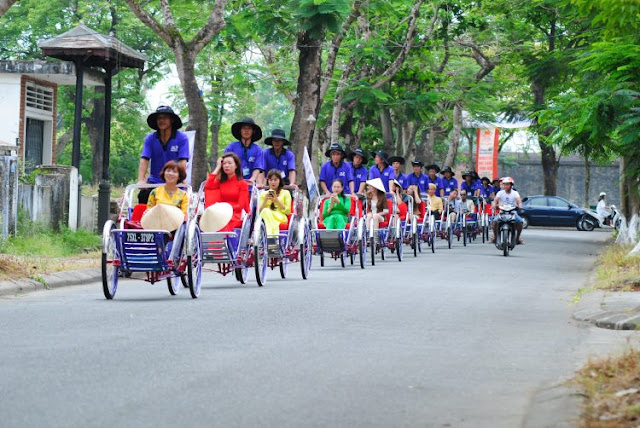
Cyclo is one of the most primitive means of transport dating back to the early 20th century of Vietnam. After the “motorbike –boom” at the beginning of 21st century, cyclo became redundant people needed to travel farther and faster. Nowadays, cyclo only remains in some cities of Vietnam and chiefly serves foreign tourists. With the low speed, cyclo offers you the best way to admire the charming beauty and enjoy the tranquility of Hue.
Normally, the total price depends on the distance, and sometimes on the weather condition. Remember to ask the price clearly to reach an agreement before setting off on the trip. You also have to watch out for any negotiating tricks, make sure that the amount negotiated covers the return trip.
By bicycle – The most interesting way

Hue has a pretty light traffic, that’s why Hue is a wonderful place to rent a bike and scrolling around. Many hotels rent out the bicycles for about VND 20,000 – VND 30,000/day. You also can rent a bike from the rental bike shop.
By motorbike – The most flexible way

Motorbike is the most common means of transport in Vietnam. It’s also the favorite way to explore the city of many foreign tourists. With a motorbike, you can travel to anywhere you like, and whenever you want. The traffic here is light and isn’t as crazy as the traffic in Hanoi and Ho Chi Minh City. Therefore, traveling around by motorbike is a great choice. You can rent a motorbike in your hotel for VND 120,000 – VND 200,000/day, depending on the kind of the motorbike.
Note:
- The requirement of renting a motorbike: Passport, ID, Driving License.
- Speeding & Speed limits: In the city, speed limit allowed is 40km/hour
What to do and see in Hue
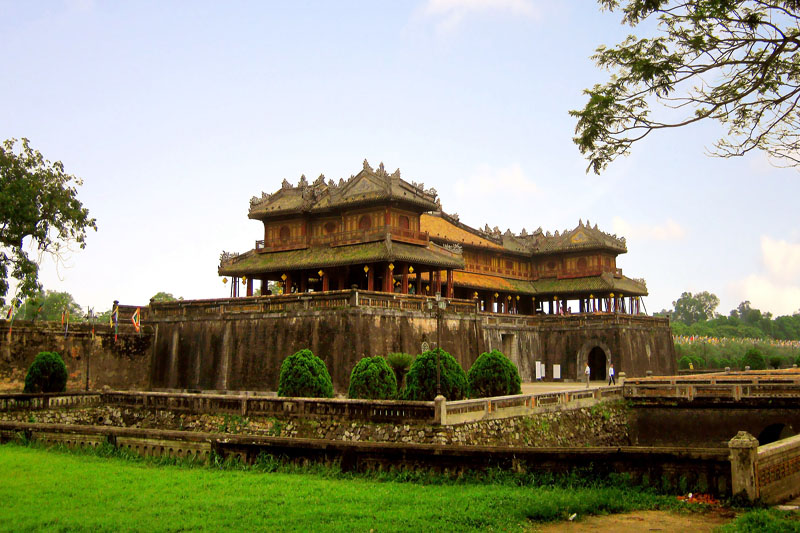
Hue is full of interesting historical sights that will bring the history of Vietnam to life in a very special way. When you come to this city, be sure to take enough time to see the wonderful places here, because quite honestly, if you just rush through, you will really miss out.
1. The Citadel
The history
Since the Vietnamese emperors and their families used to live in Hue, the evidence of their lives is still very present in the city today. To get an idea of what it was like and how imperial Vietnam was run, head over to the Citadel. It’s made up of several parts and covers quite a large area in the city center, so you can’t miss it.
The Citadel was the outer-most part of the city and is surrounded by impressive brick walls and a moat fed by the Perfume River. Today the inside of the Citadel is full of businesses, shops, and some remaining historical buildings. Back in the day, this is where the main administrative work was carried out and the military’s central commanders sat.
…and the Imperial City
The Imperial City is located inside the Citadel, where the emperors and their family used to live. On the map, it looks like a smaller square inside the Citadel, on its southern side. This space is also behind thick walls and was only accessible to selected guests and servants. Enter the Imperial City through the beautifully restored Noon Gate and imagine your surroundings bustling with high-ranking officials, foreign dignitaries and serving staff to get an idea of how grand this place once was.

Finally, at the very center of the Imperial City, you will find the Forbidden Purple City. This is where the emperor’s consorts lived. Back then, the only people who were allowed to access this place were the emperor himself and the eunuchs serving the royal consorts. It was the most safely guarded place in the entire country. Unfortunately, most of it was destroyed during the Battle of Hue, during the Vietnam War, but work is underway to restore as of it much as possible.
2. Hue’s Royal Tombs and Pagodas
Once you’ve explored the Citadel thoroughly, it’s time head to the outskirts of Hue and into the countryside to see the city’s other historical gems. The royal tombs and pagodas are located along the Perfume River and are dedicated to members of the imperial family. Each one is different and special in its own way, so be sure to visit the main tombs below.
Thien Mu Pagoda
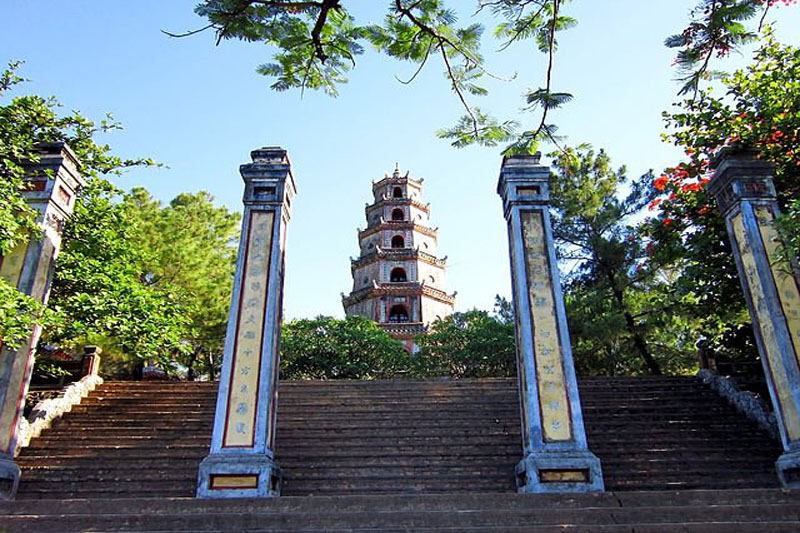
Thien Mu is located a short distance outside of Hue and overlooks the Perfume River. Its beautiful structure and design have become a symbol of the imperial city, known by local and international visitors alike. Built in 1601, this seven-story pagoda is an important religious site but also has a reputation for being at the center of various political demonstrations. Stop by to visit the pagoda, see the car used by the infamous burning monk and Buddhist martyr Thich Quang Duc, and learn his background story.
Emperor Minh Mang’s Tomb
In An Bang village, twelve kilometers outside of Hue, you will find Emperor Minh Mang’s tomb. It was built by his son and successor Thieu Tri and consists of several buildings, pagodas, and a lake. Climb up the steep staircase to enter the compound through its imposing, beautiful gate and reach the main courtyard. From there you can see the temple honoring the emperor and empress, visit Minh Mang’s sepulcher and go on a stroll around the expansive grounds.
Emperor Khai Dinh’s Tomb

Although Emperor Khai Dinh was quite unpopular with the Vietnamese people, his tomb is among the most visited sights in Hue. Made with rich decorations such as detailed ceramic and porcelain ornaments, this tomb is highly elaborate. It’s famous for its impressive mix of European and Vietnamese architectural styles which is said to stem from Khai Dinh’s travels to Europe where he was impressed by the style and designs of the buildings he saw.
Emperor Tu Duc’s Tomb
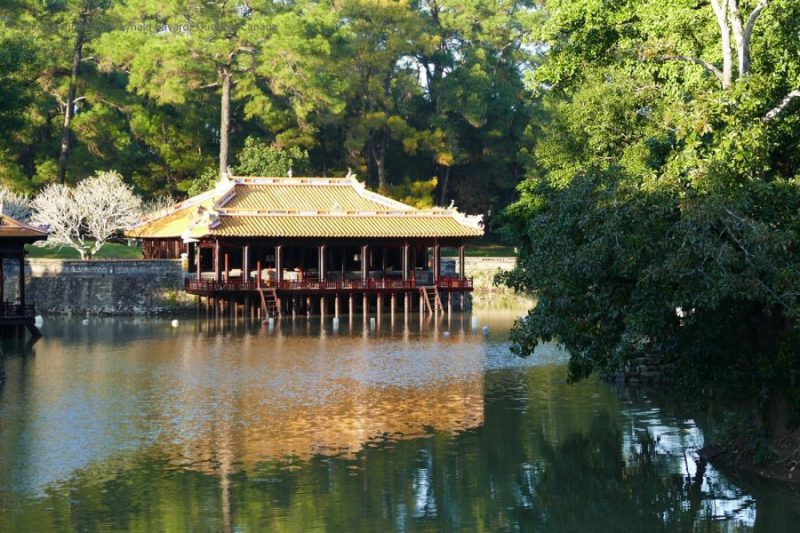
Emperor Tu Duc’s tomb is one of the most visited in Hue and should not be missed. Tu Duc was the Nguyen dynasty’s longest reigning monarch and he actually designed his tomb himself. It’s made up of several parts including the main hall, a lake with a small island, and expansive grounds covered in lush greenery. One thing that makes this place special is that Tu Duc was not actually buried here but requested to be laid to rest at an unknown location. Until today the exact place remains a mystery.
Perfume River
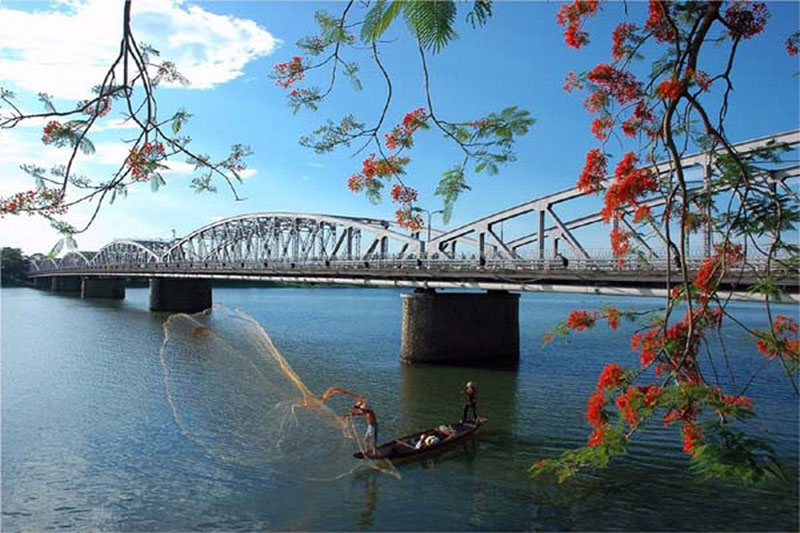
The Perfume river is as much a landmark as Hue itself. Originally named after the sweet scents of tropical flora and fauna, it quickly gained importance as a trade route that connected Hue to nearby cities and villages.
As the river gently winds its way through the city and the surrounding countryside, it offers a place of stillness and quiet, quite contrary to the hustle and bustle of the city. Come out here to take a walk along the river banks and spot several historical sites on its shores.
3. Vong Canh Hill

Vong Canh Hill, the 43-meter high hill, is located 7 kilometers from the center city. As its name suggests (“Vong” means “watch”, “Canh” means “scene”), Vong Canh Hill is the best place to catch a panoramic view of Perfume River. From the top of the hill, you can enjoy the natural beauty and the tranquility of Hue. In front of your eyes is a harmonious, attractive picture of peaceful villages stretching along the river banks, small boats quietly skimming and the green corn field inscribed by the pine trees.
Vong Canh Hill is surrounded by many royal tombs. Coming to Vong Canh Hill, you will have chances of visiting many royal tombs such as King Tu Duc’s, Dong Khanh’s, and Thieu Tri’s’ tomb. You can also visit the Water plant Van Nien which is the Oriental-styled building designed by a French architecture.
4. Nam Giao Esplanade

Nam Giao Esplanade is the monument where Nguyen Kings used to come to give offerings the God annually in the spring. In spite not being in the intact condition, Nam Giao Esplanade is still the largest one in Vietnamese history left.
This monument consisted of three terraces which symbolized three agents including heaven, earth, and man. The topmost terrace is “Vien Dan” symbolizing Heaven. Vien Dan has circle shape and is surrounded with blue-painted parapet. There is a stone called “Thanh” piercing with the circular holes on the surface. Right below the Vien Dan is Phuong Dan – the square terrace symbolizes Earth. This terrace is surrounded with yellow-painted parapet. The lowest terrace is also square and symbolizes human. All three terraces feature doors at very four sides: East, West, South, and North.
Vietnamese and Chinese people used to think that King was the son of the Gods. Nam Giao Ceremony was a ritual, solemn ceremony of Nguyen Kings to show the respect and to worship their parents (heaven and earth). The first ceremony was held in 1807 and from then on it was held annually in the spring until Thanh Thai times in 1907, it was ordered to hold every three years by the King because he realized this ceremony is too costly. Nam Giao Ceremony was also an occasion when the Nguyen Kings pray for timely rains and favorable weather as well as peace to their country. That’s the reason why for the Nguyen Kings, Nam Giao Esplanade was the most sacred place that needed to be kept well. Visiting Nam Giao Esplanade, you will have chances of understanding more about the history and culture of ancient Vietnam.
5. An Dinh Palace

Located by the bank of An Cuu Canal, An Dinh Palace was the palace where Bao Dai King, the last king of Vietnamese feudal court, and his family lived from 1945 to 1955. After several restorations and conversations carried out strictly to UNESCO standard, recently An Dinh Palace has been opened for tourists by the Center for Preservation of Hue Relics.
In the beginning, An Dinh Palace was built to be the private residence of the king Khai Dinh. After officially acceding to the throne, the King Khai Ding continued to renovate this palace in modern European style between 1917 and 1919. It’s the special aesthetic sense and eccentric mental sense of the king Khai Dinh that created the unique feature of this palace.
Come to this site, you are free to explore the beauty of the sophisticated decoration at Khai Tuong Pavilion. This pavilion consisted of three stories, all of which were designed in modern European style and were constructed by a modern material. At the first floor, An Dinh Palace features the wall paintings with many remarkable western style paintings survived in Vietnam from the early 20th century. In addition, this palace serves as a museum with over 40 photos, 100 original objects and 30 documents on display reproduces lives of this royal family.
Read more: How to Get from Da Nang to Hue (& Vice Versa)
6. Off the Beaten Path: Lesser-Known Sights Around Hue
Finished all the sights but still have some time on your hands? Then you’re in luck because Hue has some more great places that are not as well known to visitors but definitely worth a visit.
Ho Thuy Tien: Hue’s Abandoned Amusement Park
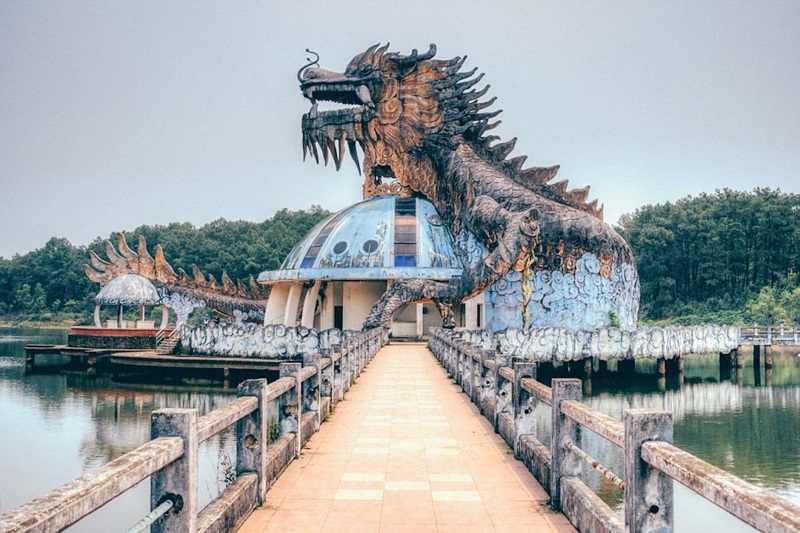
Opened in 2004, this water and amusement park was only operated for a few short years before being closed down. Originally it was planned as a place for families to come enjoy a weekend of fun rides, interesting aquariums, and entertaining shows. Today it has become a popular place for those who like the eerie feeling of all things abandoned. If you’re one of them, Ho Thuy Tien is a great way to spend a few spare hours.
Located just about eight kilometers outside of Hue’s main tourist area and clearly indicated by signs, it’s easy to find and get to. The park is open, so you don’t need to climb any fences or sneak past security guards to get in.
Once you reach it, stroll around the abandoned buildings, past the immobile rides and empty aquariums. Climb up inside the dragon in the lake and get a sweeping view of the park and its surrounding landscape. Seeing this place that was meant for fun in a silent standstill will make you feel like you’re in a disaster-stricken place that people deserted long ago.
For the best photos, go in the early morning or around sunset. That way you’ll get some cool visual effects and the long shadows will add to the park’s unnerving atmosphere. If you prefer to join an organized tour, you can opt for a Thien An Monastery, Ho Thuy Tien Park, and Thuy Bieu Village Motorbike Half Day Tour.
Hidden Paradise: Hue’s Beaches

If an abandoned theme park is not really your thing, there are plenty of more pleasant and vibrant places to visit around Hue. If you’ve just come from Ho Thuy Tien, you probably don’t want to feel like the world has ended. Instead, head over to some of Hue’s beautiful beaches to relax and take in a breathtaking sunrise.
While Da Nang and Hoi An usually get all the credit (and the visitors!) for their wonderful coasts, Hue boasts equally wonderful beaches that are not nearly as busy. For a refreshing swim, a wonderful view of the surrounding majestic mountains and a colorful sunrise, go to Luang Co and Thuan An. Soft white sands and blue waters welcome you there and you’ll probably be surprised why such a great place attracts so few tourists. So, pack your bathing suit and a towel, and get going.
Bach Ma National Park
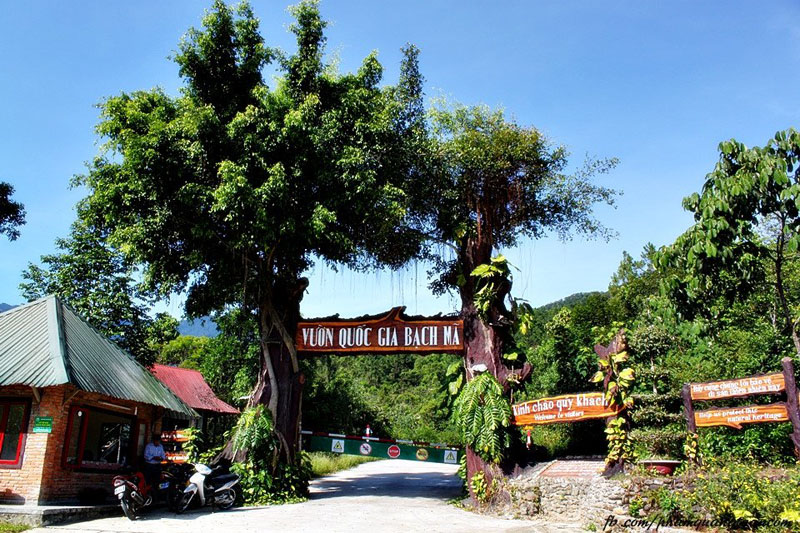
Outdoorsy and adventurous travelers will love a trip to Bạch Mã National Park. It’s about 45 kilometers from Hue but worth the drive if you love being out in nature. In Bạch Mã you can go for treks, walks and even some rock climbing to a stunning backdrop of verdant hills. Climb all the way to the top of the park’s main mountain at 1,500 meters and enjoy a sweeping view of the surrounding countryside, the Dam Cau Hai Lagoon and on days with good visibility, even the ocean.
Bạch Mã is also the home of many rare species of plants, birds and insects, so tread lightly and you might get to see some of its special residents. If this is something you are particularly interested in, get a local guide to show you the best spots for bird and animal watching. Get ready to see bulbuls, malkohas, herons and egrets to name only a few of the over 350 native species.
The park offers single day tickets or even an overnight camping option. So, if you’re not pressed for time you can spend the night under the stars in Bạch Mã.
Check the price for Bach Ma National Park Trekking Day Tour here
Picturesque Bunker Hill and Vibrant Incense Road

Off the well-worn path of this charming city, there hides a hill with mossy bunkers, from which you can see a beautiful bend in the gentle Perfume River and imagine how soldiers used to observe their region from this point. Despite its history, this hill has a romantic name: Vong Canh Hill, which means the hill to contemplate nature. Among the old pine tree lines, a cluster of concrete bunkers quietly reveal hints of the past to those that can find them. These bunkers were built by the U.S. army over half a century ago, in order to block this hill as a strategic geographic point in battle. And yet, today, these bunkers sit silently as old friends reminding us that wars pass and nature reclaims her earth.
The hill is only seven kilometers from the city, so you can reach it by car, motorbike, or even a bicycle if you want to be environmentally friendly! On the way to this hill, you will have a chance to pass through the vibrant incense-making village. The village is accessible through Huyen Tran Cong Chua street. It used to serve as the main incense supplier for Hue, however now it is a quiet place that sees a few tourists. You can learn about its history, maybe even make your own incense, as well as understand how the locals create colorful bunches of these celebratory artifacts. If you are interested, the artisans will he happy to show you how to make them yourself.
You should reach bunker hill at sunset. At this special moment, the Perfume River reflects the light with genuine royal beauty. If you have good eyesight or a camera, you can also zoom in to witness the boats floating leisurely. If you choose this moment to visit the hill, you should expect to arrive at the incense village no later than 4 PM.
Thanh Toan Bridge (Cầu Thanh Toàn)
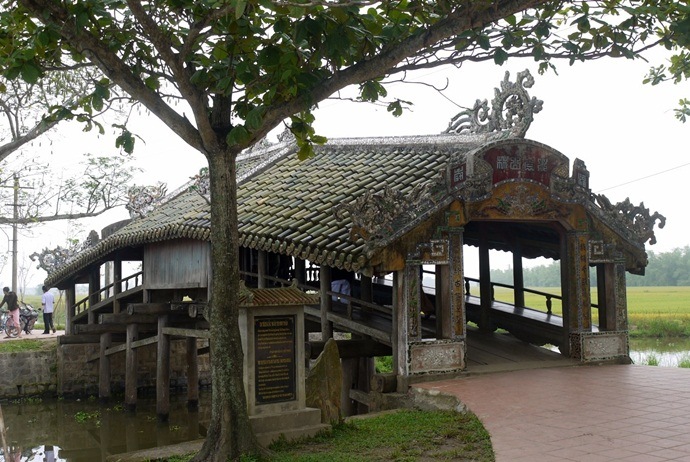
Thanh Toan Bridge is the sister bridge of the famed Japanese bridge of Hoi An. This bridge is arguably much more distinct as it has both Japanese and Chinese features, with rare squared timber arch dotted with ancient ceramics. This bridge is hard to find yet the countryside trek is really worth it.
Thanh Toan tile-roofed Bridge is about 18.75 meters in length and 5.82 meters in width. On both sides of this bridge, you will see rows of wooden platforms and parapets for visitors to lean against. Thanh Toan Bridge was often used as a place for relaxing for villagers after hard field work or tourists after sightseeing.
The thing that makes an interesting diversion of Hue lies in the classic covered Japanese footbridge put in picturesque countryside. From outside, this bridge looks like a house. The main decoration of the bridge is on its roof with patterns of “turtle, dragon, turtle, and phoenix”. The tile-roofed Thanh Toan Bridge is not just an ancient architectural construction with highly cultural and historic value but also one of well-known Hue attractions. Similar to most of other historical Hue attractions, Thanh Toan Bridge has been ruined a lot of times by floods, storms, and wars. Nevertheless, each time this bridge was damaged, the locals always repaired, renovated and preserved it well as the result of their high awareness of historical relic perseverance and their gratitude to its respectful founder.
Thanh Toan Bridge spans a canal in the suburb about 7 kilometers east of the city of Hue. You could go there by hiring a motorbike, a bike or a taxi. Whatever means you choose to travel, your trip will definitely take you through a peaceful and beautiful rural landscape. The bridge itself is renowned to have been established in the time of King Le Hien Tong (Lê Hiến Tông) right in the mid 18th century.
Check the price for Thanh Toan Village Half Day Tour here
Tam Giang Lagoon (Đầm Tam Giang)

The last one in this list of Hue attractions is Tam Giang Lagoon which is about 24 kilometers in length and covers an area of 52 km2. Belonged to Phong Dien (Phong Điền), Quang Dien (Quảng Điền), Huong Tra (Hương Trà), Thua Thien Hue province, Tam Giang Lagoon stems from Thuan An (Thuận An) harbor. Here, small boats sweeps on the river named O Lau, along the lagoon length. Passing over 15 km of fields and bridges along the lagoon, you could reach Thai Duong Ha village. Then, after traveling by boat for 30 minutes, you come to the island on Tam Giang Lagoon, in which there is an ancient village named Thai Duong.
The most beautiful moment on this lagoon is at sunset when the sky turns supple. Tam Giang local people survive thanks to catching shrimp and fish. Males will go fishing offshore. Before the sun breaks over the horizon, they have to collect shrimp and fish from traps. At dusk, they reset nets and traps. At the same time, females toil to catch calm and oysters because they have to soak their own body in the water for a few hours in order complete their work.
The lagoon itself is also home to a lot of birds’ species and various fauna and flora species. It is also like a huge air-conditioning area, contributing to present storms in Hue. Locals call Tam Giang – Cau Hai (Cầu Hai) an unopened treasure.
If you want to visit Tam Giang Lagoon, consider a recommended tour below. Such tours help connect you with the locals and supply you with some basic services and guiding information about this region.
Best things to do in Hue
1. Shop at Dong Ba market
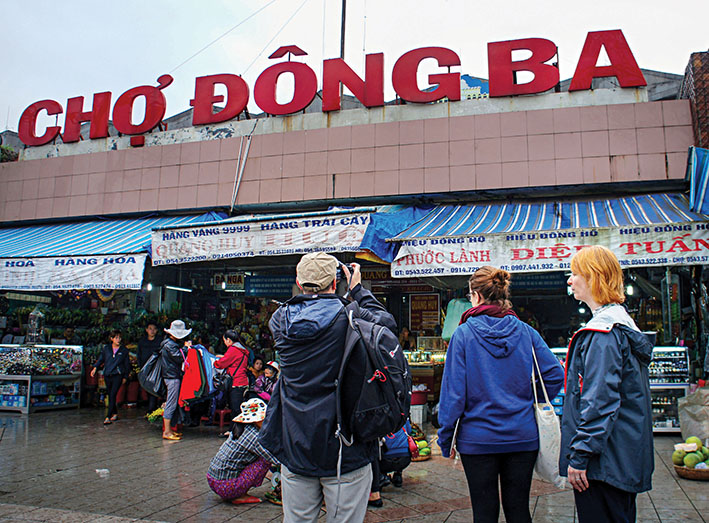
This may be one of the most relaxing things to do in Hue. If you are keen on discovering Hue city via the traditional products, it is highly recommended to visit Dong Ba (Đông Ba) Market. Considered as the largest market place in the central area of Vietnam, Dong Ba market is a definite place to immerse yourself in the culture of people here. Once visiting here, tourists hardly get out soon as they are strongly absorbed by myriad items as well as local specialties. You could see various features of a traditional Vietnamese market, like the bazaars, the bus station, the sampan landing. A variety of traditional crafts which reflect the ancient cultural features of Hue could be found here like Hien Luong (Hiền Lương) scissors, Phu Cam (Phú Cam) conical hats, Ke Mon (Kế Môn) jewelry, Phuoc Tich (Phước Tích) pottery, Nam Thuan (Nam Thuận) sweets, Tinh Tam (Tịnh Tâm) lotus, and bamboo products. In addition, Dong Ba market is an abundant source of many local daily dishes, for instance, beef noodles, bean puddings, shrimp cakes, pancakes, clam rice, sour shrimps and so on.
Here, you will also see a lot of everyday activities and shop everything from souvenir items to Hue sesame sweetmeat, bronze goods, conical poem hats, etc. If you are really interest in Vietnamese culture and food, you should come here to explore. Despite a few new markets have emerged within Hue City, Dong Ba market still remains its crucial role as the biggest market where various commercial activities happening daily.
2. Climb up the Ho Quyen, Tiger Fighting Arena and Long Chau Temple

One of the most interesting things to do in Hue is visiting Ho Quyen (Hổ Quyền), the tiger fighting arena. This site was established in 1830 during the regime of Emperor Minh Mang to stage battles between a tiger and an elephant annually. This is an Asian version of the Roman coliseum. It was used for entertaining the Emperor and his family and nobility. Sadly, today, it is overlooked by many tourists. The arena contains two circular, thick walls around an earthen rampart, with the stairs leading to the highest position of the wall, one being reserved for the Emperor as well as his family while the remaining for the rest of the court along with commoners. In opposite to the royal rostrum, there are five tiger cages with the claw marks visible in the walls. The fight was like a professional wrestling. Prior to the fight, the tiger was manipulated drugged, and had it fangs and claws removed. If the elephant sent into fight could not do the job, another one was sent to support. Then, the elephants always won. Why? The tiger was symbolized rebellion while the elephant was symbolized the monarchy.
Another suggestion you can consider among many things to do in Hue is to visit Long Chau (Long Châu) temple, which is located on the south bank of the Huong River. This is a royal temple in which the kings’ war elephants were respectfully buried and worshiped. It is also known locally as “Dien Voi Re” (Điện Voi Ré), meaning the “Palace of the Crying Elephants”. This site is situated about 200 meters from the Ho Quyen arena, where tigers and elephants dueled to the death. The temple looks out over the big pond filled with lotus where it is said the triumphant elephant went to relax after having a successful fight. Up to now, the spot is not maintained well and needs to be conserved carefully. Ho Quyen arena and Long Chau temple are very much worth including in your list of things to do in Hue if you want to explore more historic aspects of the ancient city of Hue.
3. Enjoy the Brass Works
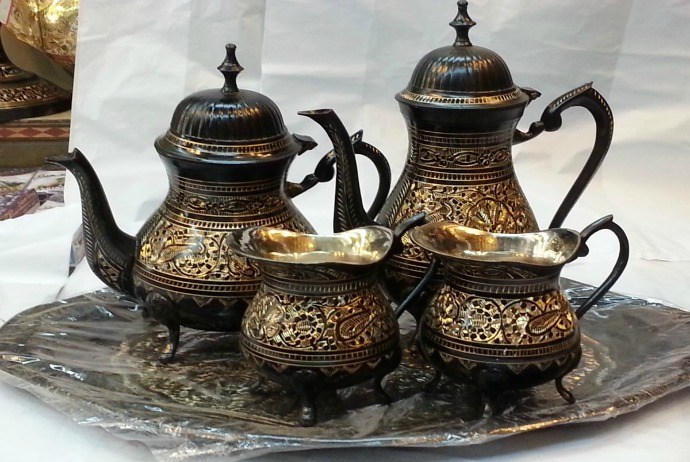
This is one of little-known things to do in Hue for many tourists coming Hue. But, it is worth a try. From Tu Duc tomb, you can take a stop at the Brass Works. The outfit used here makes massive brass statuary for purchasers worldwide. The smiting and forging are done by using the fundamental techniques. The craftsmanship is very impressive.
- Opening hours: 8 am – 5 pm
- Location: No.48 Huyen Tran Cong Chua (Huyền Trân Công Chúa), Hue (Huế) City, Thua Thien Hue (Thừa Thiên Huế) Province, Vietnam (Việt Nam)
4. River Cruise
A journey to Hue will not be complete if without a cruise on the Huong River. With two options of different styles of cruise that cater to all tastes, this idea of things to do in Hue is very interesting for most tourists. You could not walk along the bank of Huong River without paying attention to the dragon boats that putter past. The morning route could be hopping onto a small yet long dragon boat to start your sightseeing. In this route, Thien Mu (Thiên Mụ) pagoda is the first stop (taking about 25 minutes to reach), Minh Mang (Minh Mạng) mausoleum is the next (taking about 1 hour to reach). Along the way meandering up the river, you can see many fantastic views. Just simply rest back in the seat and feel the cool breeze blowing along the boat’s side.
Another romantic idea is to enjoy a relaxing tradition large dragon boat cruise whilst comfortably sipping champagne in the late afternoon. From the harbor, you head towards the pagoda before turning around to have a cruise down the river under both the Phu Xuan (Phú Xuân) and Truong Tien Bridges. Before coming back to your hotel, you can still immerse yourself in a traditional custom of locals: lighting and releasing the candlelit lantern.
If you want to visit Huong River, consider Traditional Singing Performance on Huong River Ticket in Hue.
5. Visiting Hue Night Market and discovering the daily life of the locals
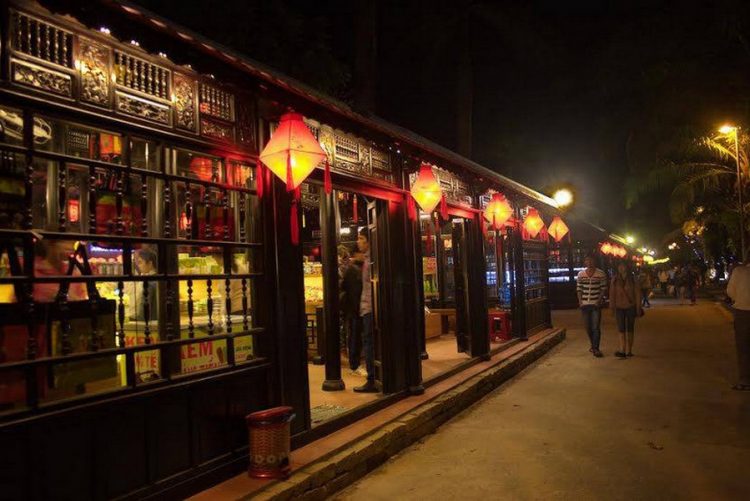
Located on the Nguyen Dinh Chieu walking street, Hue Night Market has busy, the animated atmosphere which is completely contrasted to the tranquility of Hue in the daylight. Hue Night Market often opens from 17:00 to 23:00. Hue Night Market has more than 122 stands divided into three sections including traditional handicrafts, consumer goods, and cuisine.
Visiting Hue Night Market, you will amaze at a variety of sophisticated handicraft, eye-catching souvenir, and lovely decorative items. In addition, Hue Night Market is the perfect places to enjoy tasty local cuisines such as com hen (mussel rice), bun bo hue (Hue beef noodle), and banh la (leaves cake). Hue Night Market is also a place where most quintessence products of Thua Thien Hue Province gather including Phu Cam conical hat, Ke Mon jewelry, Song Hy sesame candy, Truoi berry and lotus seed of Tinh Tam Lake.
6. Watch the amazing Ao Dai Show

A stunning show for those who love Hue and wish to see into the soul of Hue can find in the Ao Dai Show. This show features the recreation of The Nguyen Dynasty’s practices, wonderful dance performances such as Hue Royal Show, Cup Dance, Royal Paper Fan Dance, and Lotus Dance, Traditional Martial Art with sword fight performed by professional artists, and a variety of Vietnamese traditional costumes such as Ao dai and royal garments. A royal performance for you and family to immerse in the aesthetic space of precious legacy from the Nguyen Dynasty and get to know more about the history of Vietnam. A royal performance for you and family to immerse in the aesthetic space of precious legacy from the Nguyen Dynasty and get to know more about the history of Vietnam.
Do not miss and book Ao Dai show here.
What to eat in Hue
1. Mussel Rice (Com hen) – The low-priced specialty of Hue
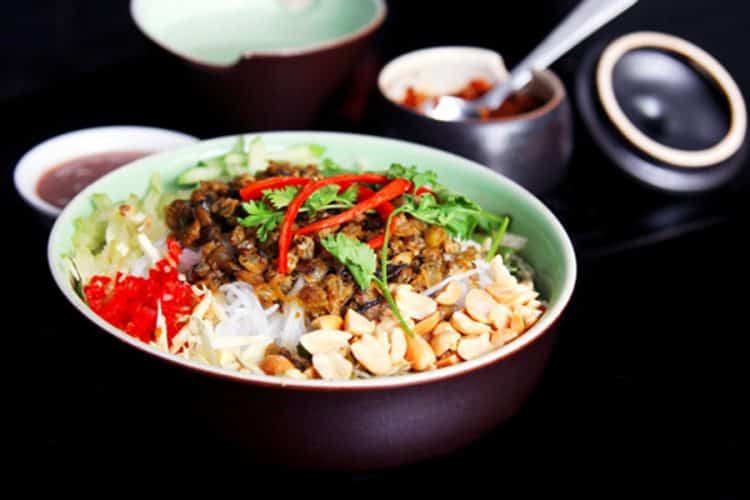
Com hen is a low-priced specialty you must try when visiting Hue. Made from river mussel, rice together with more than 13 different raw materials, com hen has a combined flavor including sweet, buttery, salty, sour, bitter and spicy flavors. To make com hen, firstly people soak fresh river mussel in rice water for a long time to remove impurities. Then, they boil mussels until they open their mouth. After that, gently scrape the meat off the shell. Mussel meat is fried with oil, dried bamboo shoot, rice vermicelli, white sesame, chili sauce and fish sauce. Fried mussels are put on the top of the bow of rice with peanut, salted shredded meat, fried pork rind. Com hen is served with a lot of fresh vegetable including banana flower, banana trunk, spicy vegetables, peppermint, and salads.
Where to eat com hen
Hoa Dong Restaurant
Address: No. 64, Kiet 7 Ung Binh, Con Hen, Hue City
Price: VND 8,000 – VND 20,000
Open: 06:30 – Close: 20:00
Bun, Chao, Com Hen Restaurant
Address: No. 98, Nguyen Hue, Hue City
Price: VND 10,000 – VND 22,000
Open: 07:00 – Close: 22:00
Tam Phuc Restaurant
Address: Kiet 7 Ung Binh, Con Hen, Hue City
Price: VND 15,000 – VND 33,000
Open: 07:00 – Close: 22:00
2. Hue Beef Noodle Soup – Bun Bo Hue

It’s no doubt that bun bo Hue is a key factor contributing to the golden reputation of Hue. Bun Bo Hue now appears in almost all regions of Vietnam, but its tastes vary a bit. Bun Bo Hue is greatly admired for its balance of spicy, sour, salty and sweet and the predominant flavors.
The consommé is made by simmering beef bone. Then, it is seasoned with fermented shrimp sauce, sugar, and spicy chili oil to enhance the flavor. A bow of Bun Bo Hue includes soft rice vermicelli (bun), some slices of medium beef, chunks of oxtail, boiled beef shank and two or three small cubs of congealed beef blood. Bun Bo Hue is often served with lime wedges, cilantro sprigs, spring onion s, raw sliced onions, chili sauce, banana flower, banana trunk, red cabbage, mint, basil, perilla, and Vietnamese coriander (rau răm).
Where to eat bun bo Hue
Bun Bo Hue O Cuong Chu Diep (Mrs. Cuong & Mr. Diep)
Address: No. 06 Tran Thuc Nhan Street
Price: VND 15,000 – VND 30,000
Open: 06:30 – Close: 11:00
Bun Bo Mrs. Phung (Bun Bo Mr. Vong)
Address: No. 05 Nguyen Du Street
Price: VND 20,000 – VND 45,000
Open: 15:00 – Close: 18:00
Cam Restaurant
Address: No. 38 Tran Cao Van Street
Price: VND 20,000 – VND 40,000
Open: 06:00 – Close: 10:00
3. Sweet Soup (Chè Huế) – The best street food in Hue

Chè Huế is a specialty appearing in every corner of Hue. Chè Huế, sometimes misunderstood as tea, is actually a sweet dessert with more than 36 types of different ingredients, colors, forms, and tastes. Chè Huế is often made by simmering red beans, green bean, black eye peas, lotus seeds, coconut milk together with many types of fruit.
Some popular types of Chè Huế are che bap (corn sweet soup), che hat sen (lotus seed), che troi nuoc (sticky rice ball and green pea paste), che khoai mon (taro), che buoi (grapefruit) and che dau do (red kidney bean). Despite many types, Chè Huế is divided into 2 main kinds: the royal sweet soup and alley sweet soup. Both kinds are scrumptious, gently sweet and have a good smell, which makes you can’t stop eating.
Where to eat chè Huế
Chè Huế Ngoc Hien
Address: No. 65 Tran Hung Dao Street
Price: VND 8,000 – VND 10,000
Open: 15:00 – Close: 21:300
Chè Huế Mr. Lac
Address: No. 36 Thanh Tinh Street, Vi Da Ward
Price: VND 5,000 – VND 11,000
Open: 12:30 – Close: 11:00
Che Mo Ton Dich
Address: Opposite to Thuong Bac Park
Price: VND 8,000 – VND 20,000
Open: 17:00 – Close: 22:00
3. Hue Royal Cuisine – The unique characteristics of the ancient capital

Royal Cuisine of Hue receives the golden fame for its sophistication and refinement. Hue Royal Cuisine is unique not only due to the delicate culinary process but also thanks to the sophisticated presentation that makes it look like an artwork.Enjoying Hue Royal Cuisine while immersing into the charming melody of Nha Nhac will be the unforgettable experience for many visitors.
_____Ton Nu Thi Ha (Hue Culinary Artisan) _____
Where to eat Hue Royal Cuisine
Royal Park Restaurant
Address: No. 03 Nguyen Sinh Sac Street, Vi Da Ward
Tel: (+84)-234-389-7202
Hotline: (+84) 913-492-356
Email: cungdinh@royalpark.com.vn
Website: www.royalpark.com.vn
Price: VND 550,000 – VND 1,100,000
Open: 07:00 – Close: 23:00
Where to live in Hue
Hue has a plethora of resorts, hotels, homestays, and hostels to choose from, along with the benefit of low prices garnering fairly high value. Compared to the rest of Vietnam, you’ll find accommodation priced slightly lower, while still maintaining excellent service, location, and amenities, regardless of hotel class.
1. Hue hotels
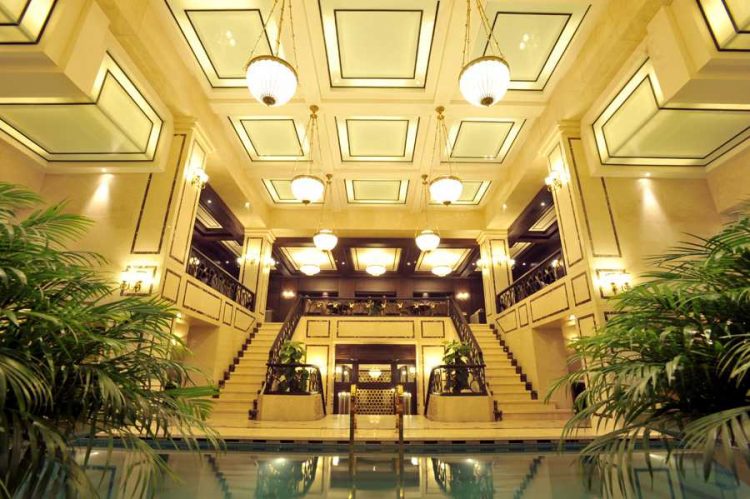
The most popular choice that most of tourists visiting Hue consider is staying at the hotel in city center. The center of Hue is small and most of hotels are located nearby on Le Loi Street, Nguyen Cong Tru Street, Vo Thi Sau Street, Nguyen Thai Hoc, and Ben Nghe Street south of Perfume River, which is called the backpacker area. This area is quite convenient as you can travel to various tourist attractions from there. Crossing the Trang Tien Bridge to see the Citadel and Dong Ba Market on foot is also easy.
This area in the center of Hue is where most of 2-star and 3-star hotels are located so room prices here are really reasonable. And of course, if you prefer, you can find a 4-star or 5-star hotel to ensure the most comfortable stay.
Recommended Hue hotels in a really convenient location: Amigo Hotel, Hue Garden Villa Hotel, Hotel Saigon Morin, Moonlight Hotel Hue, Eldora Hotel, Indochine Palace, Imperial Hotel Hue
2. Hue resorts
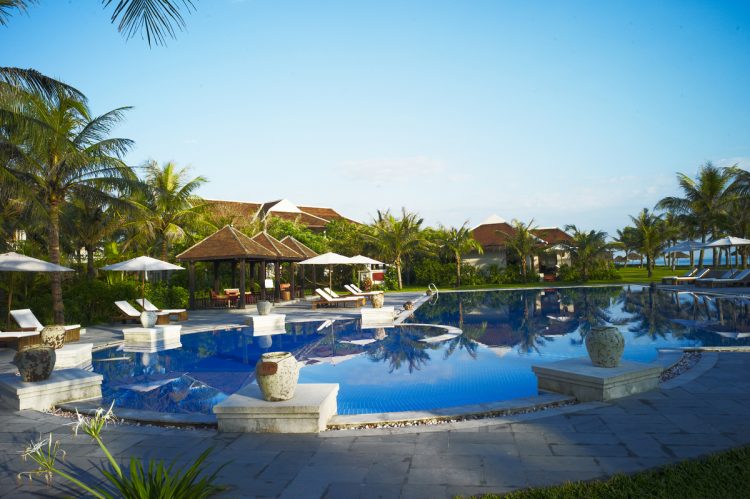
If the purpose of your trip is relaxing in the beautiful nature and enjoying the peaceful atmosphere, then staying at one of the resorts in Hue would be a perfect choice. There are plenty of quiet and enticing beaches nearby the city, including Thuan An and Lang Co. However, the room rates at high-class resorts in Hue are relatively high. These resorts are the place for your dream vacation in the ancient tropical paradise.
Some of the best resorts in Hue: Angsana Lang Co, Banyan Tree Lang Co, Vedana Lagoon Resort & Spa
3. Hue homestays
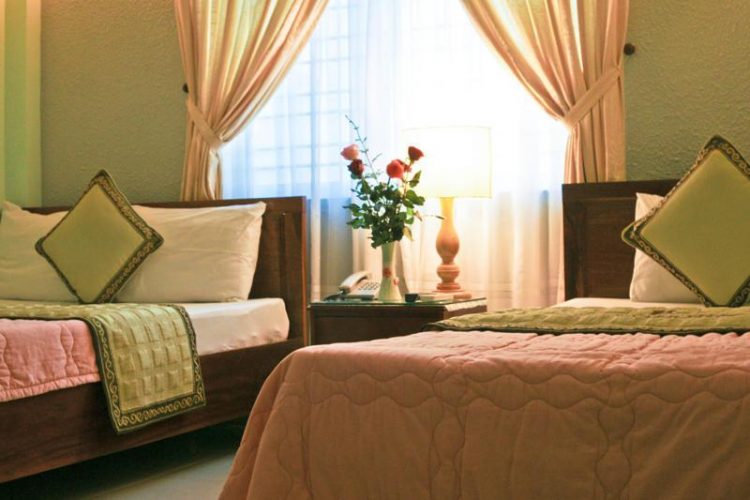
Homestays are popular in Hue because they are run by locals. Homestays in Hue meet the needs of travelers, offering a good service at affordable prices with friendly local people. Unlike the traditional homestay in other places, which must be shared with the host, most of homestays in Hue allow tourists to enjoy private space as they are like apartments separated from the owner.
Staying at a homestay in Hue is a good option for those who love history and culture. You will feel that the customs and lifestyle of the Hue people are still retained and handed down in these homestays. Typically, a standard homestay also has a nice small garden, so you can feel like being at home.
Homestays in Hue are very affordable. For the room rate from VND 200,000-350,000 per night, you can stay in a very nice and lovely space right in the heart of Hue City.
Some of the best Hue-style homestays: Citadel Homestay, Eva Homestay, Hue Sweethouse 2 Homestay
4. Hue hostels

There are a number of cheap and good hostels in Hue. Room prices are suitable for those who are traveling on a budget or just want to explore Hue and don’t care much about comfort of their stay. If you don’t mind much about the location, check for hostels in Vi Da Street or Nguyen Sinh Cung. Hostel room rates are usually around VND 200,000-250,000 per night.
Some of the best budget hostels in Hue: Shark Hostel, Amy Hostel Hue, DMZ Hostel Hue
Must-know tips when traveling to Hue
- When traveling by cyclo, remember to ask clearly whether the price covering the return trip before setting off.
- Take it into consideration when scrolling around Le Loi Street. This street is the center of expensive hotels, clubs, and shops. Almost all things have higher prices on this street due to its high renting fee.
- Be careful with some tourism operators who offer you to watch Nha Nhac or ca hue at a low price. The quality of this performance is quite poor.
YOU MAY ALSO LIKE


